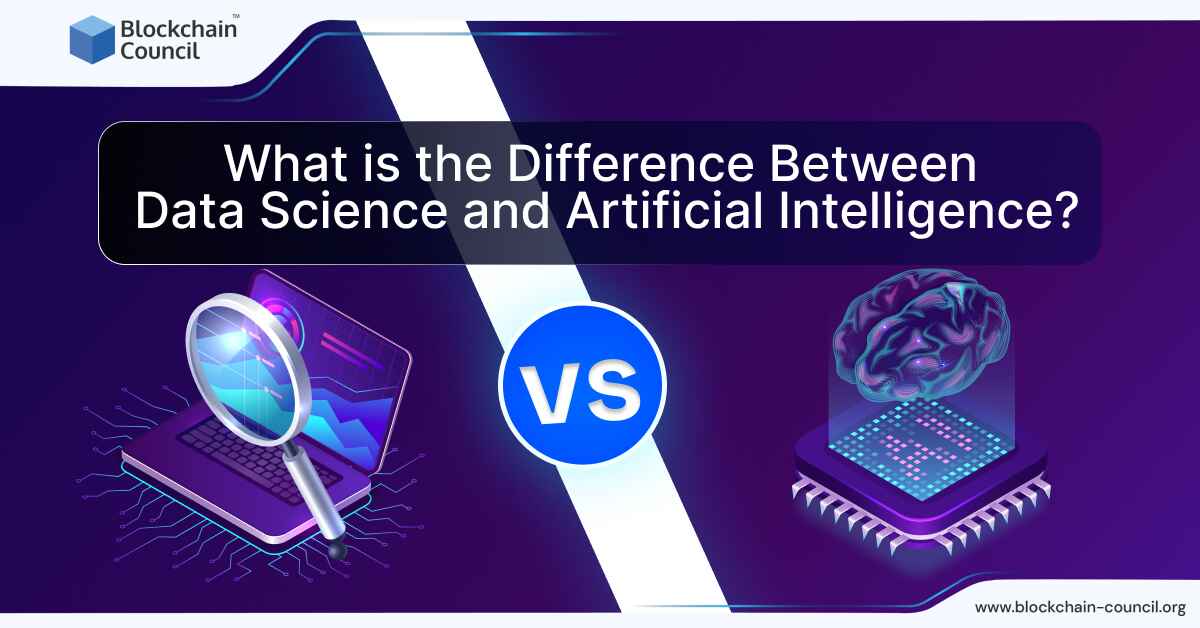
- Blockchain Council
- September 13, 2024
Summary
- Data Science and Artificial Intelligence (AI) are two distinct but interrelated fields with a significant impact on technology and industries.
- Data Science involves extracting insights from structured and unstructured data using techniques like machine learning and data visualization.
- AI focuses on creating machines that simulate human intelligence and can perform tasks like visual perception, speech recognition, and decision-making.
- Data Science finds applications in finance, healthcare, marketing, and technology, while AI is used in autonomous vehicles, smart assistants, and healthcare diagnostics.
- The history of Data Science dates back to the mid-20th century, with a growing importance in the 2010s due to big data and machine learning.
- The concept of AI has its roots in the mid-20th century, with significant advancements in machine learning and neural networks in the 1980s and 1990s.
- Core components of Data Science include data, data visualization, statistics, programming languages, and machine learning.
- Key components of AI include machine learning, natural language processing (NLP), and robotics.
- Both fields commonly use programming languages like Python and R, machine learning libraries, data visualization tools, and big data technologies.
- Data Science focuses on extracting insights from data, while AI seeks to replicate human reasoning, with collaboration and synergy between the two fields in various industries.
In the ever-evolving landscape of technology, Data Science and Artificial Intelligence (AI) emerge as two of the most compelling and innovative fields. Their profound impact on how we analyze data, make decisions, and automate processes is undeniable. However, the distinction between these fields, while subtle, is crucial for a comprehensive understanding of their roles in the current technological epoch.
Data Science is a multidisciplinary field that focuses on extracting knowledge and insights from structured and unstructured data. Artificial Intelligence, on the other hand, is all about creating machines that can simulate human intelligence. Grasping the differences between Data Science and AI is paramount, not just for academic purposes but for practical applications in various industries. Each field has its unique methodologies, tools, techniques, and objectives. Their proper implementation can revolutionize industries, enhance efficiency, and open new frontiers in technology and business.
This article aims to demystify and distinguish between Data Science and AI. We will delve into their definitions, scopes, methodologies, technologies, and many more. Understanding these nuances will provide clarity, aid in making informed decisions regarding career paths, education, and business strategies, and appreciate the unique contributions of each field to the technological advancements we witness today.
Data Science: Definition, Scope, and Key Objectives
Definition
Data Science is an interdisciplinary domain that fuses mathematics, programming, and statistics with domain expertise to analyze and interpret complex data. This field involves a variety of techniques including, but not limited to, machine learning, predictive analytics, and data visualization to unearth insights from both structured and unstructured data sets.
Scope
The scope of Data Science is vast and continually evolving. It encompasses various subfields and techniques such as:
- Descriptive Analytics: Understanding past events and trends.
- Diagnostic Analytics: Investigating reasons behind certain events or trends.
- Predictive Analytics: Anticipating future scenarios based on historical data.
- Prescriptive Analytics: Advising on possible actions to achieve desired outcomes.
Industries ranging from finance, healthcare, marketing, and technology heavily utilize data science. In finance, for instance, it’s used for fraud detection and algorithmic trading. Healthcare leverages it for disease prediction and personalized medicine.
Key Objectives
The primary objectives of Data Science are:
- Enhancing data-driven decision-making processes.
- Innovating through data-driven insights.
- Optimizing business operations.
- Developing predictive models for forecasting.
Artificial Intelligence: Definition, Scope, and Key Objectives
Definition
Artificial Intelligence (AI) refers to the simulation of human intelligence in machines. These AI systems are designed to perform tasks that typically require human intelligence, such as visual perception, speech recognition, decision-making, and language translation.
Scope
AI’s scope is broad and encompasses various technologies and subfields, such as:
- Machine Learning (ML): Enables machines to learn from data and improve from experience.
- Natural Language Processing (NLP): Focuses on the interaction between computers and human language.
- Robotics: Involves the design and creation of robots capable of performing tasks autonomously.
AI’s applications are evident across various sectors like autonomous vehicles in transportation, smart assistants in technology, and diagnostic tools in healthcare.
Key Objectives
The central goals of AI include:
- Automating routine tasks and processes.
- Enhancing human capabilities and productivity.
- Improving accuracy and efficiency in tasks.
- Developing intelligent solutions for complex problems.
Brief History of Data Science
Data Science, as a distinct field, has its conceptual roots dating back to the mid-20th century. The journey of Data Science began with the visionary insights of individuals like John W. Tukey and Peter Naur. Tukey, an American mathematician, articulated the potential of data analysis in his 1962 work, “The Future of Data Analysis,” where he anticipated the emergence of a new field focusing on data. Around the same time, Peter Naur, a Danish computer engineer, contributed significantly with his work, which included one of the first definitions of Data Science as a discipline dealing with established data.
By the 1970s and 1980s, the theoretical underpinnings of Data Science had begun to materialize into more concrete forms. The International Association for Statistical Computing was established in 1977, aiming to merge statistical methodologies with modern computer technology. This period also witnessed the first workshops and conferences dedicated to the evolving field.
The 1990s and 2000s marked a significant transition as Data Science began to be recognized as a specialized field. The emergence of big data, catalyzed by the growth of the internet and technology companies like Google and Facebook, necessitated new technologies for data processing. This era saw the rise of tools like Hadoop and the increasing importance of machine learning and AI within the realm of data science.
From the 2010s onwards, Data Science continued to evolve, with a notable increase in the demand for data scientists. The field’s expansion into various industries, the emergence of data science degree programs, and the advent of technologies like deep learning marked this era. The 2020s have been characterized by breakthroughs in AI and machine learning, indicating the ongoing and increasing significance of Data Science in our technology-driven world.
Brief History of Artificial Intelligence
The concept of Artificial Intelligence (AI), although deeply rooted in history, began to take a more concrete shape in the mid-20th century. Key milestones include the work of pioneers like Alan Turing, who conceptualized the principles of machine learning in the 1940s and 1950s. However, the term ‘Artificial Intelligence’ was officially coined in 1956 at the Dartmouth Conference, which is often considered the birth of AI as a formal field.
During the late 20th century, AI experienced several ‘winters’ and ‘springs,’ periods of reduced funding and interest followed by resurgence and breakthroughs. The 1980s and 1990s saw significant advancements in machine learning and neural networks, led by researchers like Geoffrey Hinton, who played a pivotal role in applying the backpropagation algorithm to multi-layer neural networks.
The 2000s marked a turning point as technological advancements, particularly in data storage and processing power, enabled the practical application of AI. This era saw the rise of deep learning and its integration into various industries, transforming fields like natural language processing, image recognition, and autonomous vehicles.
AI’s evolution continued into the 2010s and 2020s, characterized by its integration into everyday life and business operations. The development of AI in areas such as healthcare, finance, and transportation highlights its growing impact and the potential for future innovations.
Key Components of Data Science
Data Science, an interdisciplinary field, integrates several core components essential for extracting insights from data:
- Data: The bedrock of data science, encompassing both structured (numerical, databases) and unstructured forms (text, images, videos). Effective collection, storage, and management of these data types are fundamental.
- Data Visualization: A powerful tool for making complex data understandable through visual representations like charts and graphs.
- Statistics: This serves as the backbone for data science, involving the collection, analysis, interpretation, and presentation of data. Statistical methods are pivotal in data analysis, prediction, and inference making.
- Programming Languages: Python and R are vital in data science for their flexibility and extensive libraries catering to data analysis, machine learning, and visualization.
- Machine Learning: Involves algorithms and statistical models that enable computers to perform tasks without explicit instructions, used in applications like predictive analytics and fraud detection.
- Data Engineering: The design and management of data workflows and pipelines, ensuring data quality and accessibility for analysis.
- Industry Expertise: Tailoring analysis to specific business needs and making findings relevant and actionable requires understanding the industry context.
Key Components of Artificial Intelligence
Artificial Intelligence is characterized by components that empower machines to emulate human intelligence:
- Machine Learning: The core of AI, it includes learning algorithms to make predictions or decisions without being explicitly programmed for a specific task.
- Natural Language Processing (NLP): This deals with the interaction between computers and human language, enabling machines to understand, interpret, and generate human language.
- Robotics: The design and creation of robots capable of performing tasks autonomously or semi-autonomously, often in collaboration with human operators.
Common Technologies and Tools in Both Fields
Several technologies and tools are commonly employed in both Data Science and Artificial Intelligence:
- Python and R: These programming languages are widely used for data analysis, machine learning, and statistical modeling.
- Machine Learning Libraries: Libraries like TensorFlow, Scikit-learn, and PyTorch are instrumental in both fields for developing and implementing machine learning algorithms.
- Data Visualization Tools: Tools such as Tableau, Matplotlib, and Seaborn are used for creating insightful visual representations of data.
- Big Data Technologies: Apache Hadoop and Spark are crucial for processing and analyzing large datasets in both Data Science and AI.
Methodological Differences in Approaching Problems
Data Science and Artificial Intelligence (AI), while intertwined, approach problems with distinct methodologies:
- Data Science primarily focuses on extracting insights from data. It involves a series of steps starting with data collection and preprocessing, applying suitable models and algorithms, and interpreting the results to find patterns and make predictions. The outcomes in data science are generally pre-determined and straightforward to define from the start, such as predicting future sales or identifying maintenance needs.
- Artificial Intelligence, on the other hand, seeks to enable computers to produce outcomes from complex data that mirror intelligent human reasoning. AI’s approach begins by identifying complex tasks performed by humans that can be replicated by machines. Its process includes exploratory data analysis, breaking down the task into algorithmic components, testing with data, and refining the system’s logic and complexity. The goals in AI are more generic and challenging to define, focusing on tasks like generating creative text or images from textual descriptions.
Typical Workflows in Data Science and AI Projects
The workflows in Data Science and AI projects also exhibit key differences:
- Data Science Workflow: This involves identifying questions answerable from data, data collection, applying statistical and computational models, and interpreting results to make informed decisions.
- AI Workflow: AI projects start with identifying manual or complex reasoning tasks for automation, dividing these tasks into algorithmic components, and continuously refining and testing the system.
Interrelationship Between Data Science and AI
- Data Science’s Contribution to AI: Data Science plays a crucial role in developing AI by providing the necessary data insights, predictive models, and statistical analysis that fuel AI algorithms.
- AI’s Role in Advancing Data Science: AI enhances Data Science by introducing advanced machine learning techniques, such as deep learning and natural language processing (NLP), which allow for more sophisticated analysis and interpretation of large and complex datasets.
- Synergies and Collaborative Use Cases: Both fields benefit from their synergies. For instance, AI uses data science insights for tasks like speech recognition and smart assistants, while data science employs AI to perform complex functions like predictive analysis and customer behavior modeling. This collaboration is evident in various industries like healthcare, finance, marketing, and supply chain management, where data science and AI together drive innovation and efficiency.
Conclusion
In conclusion, Data Science and Artificial Intelligence, though overlapping and often interdependent, hold distinctive places in the technological realm. Data Science provides the foundation for data-driven decision-making and insights, whereas AI brings a level of automation and cognitive capabilities to machines. As we continue to witness rapid advancements in both fields, appreciating their individual contributions and differences becomes essential for harnessing their full potential. The future is poised for more groundbreaking innovations as we continue to explore and integrate the power of Data Science and AI across various sectors.
Disclaimer: The content on this platform is for educational purposes only. We do not endorse, recommend, or promote any product. Our articles are based on data from trustworthy sources, and our perspective is neutral and unbiased. Readers should make informed decisions and seek professional advice when needed. We have no affiliations with the products or services mentioned in our content.
Frequently Asked Questions
What is the difference between Data Science and Artificial Intelligence?
- Data Science is a multidisciplinary field focused on extracting insights from structured and unstructured data using techniques like machine learning, data visualization, and statistical analysis.
- Artificial Intelligence (AI) involves creating machines capable of performing tasks that typically require human intelligence, such as speech recognition, decision-making, and language translation.
- Data Science emphasizes data analysis and interpretation, while AI focuses on automation and cognitive capabilities in machines.
- Data Science provides the foundation for data-driven decision-making, while AI adds automation and intelligence to machines.
What are some real-world applications of Data Science?
- Data Science is widely used in finance for tasks like fraud detection and algorithmic trading.
- In healthcare, it’s employed for disease prediction, personalized medicine, and analyzing patient data.
- Marketing utilizes Data Science for customer segmentation, recommendation systems, and analyzing campaign effectiveness.
- Technology companies use Data Science for user behavior analysis, product recommendation engines, and optimizing user experiences.
How has Artificial Intelligence evolved over the years?
- The term ‘Artificial Intelligence’ was officially coined in 1956 at the Dartmouth Conference, marking its formal recognition as a field.
- AI experienced periods of reduced funding and interest, known as ‘AI winters,’ followed by resurgence and breakthroughs.
- Advances in machine learning, neural networks, and deep learning in the late 20th century paved the way for practical AI applications.
- The integration of AI into healthcare, finance, transportation, and everyday life highlights its ongoing evolution and impact.
What are some common technologies and tools used in both Data Science and Artificial Intelligence?
- Python and R are widely used programming languages in both fields for data analysis, machine learning, and statistical modeling.
- Machine learning libraries like TensorFlow, Scikit-learn, and PyTorch play a pivotal role in developing machine learning algorithms in both Data Science and AI.
- Data visualization tools such as Tableau, Matplotlib, and Seaborn help create insightful visual representations of data.
- Big data technologies like Apache Hadoop and Spark are crucial for processing and analyzing large datasets in both fields.





































































 Guides
Guides News
News Blockchain
Blockchain Cryptocurrency
& Digital Assets
Cryptocurrency
& Digital Assets Web3
Web3 Metaverse & NFTs
Metaverse & NFTs
